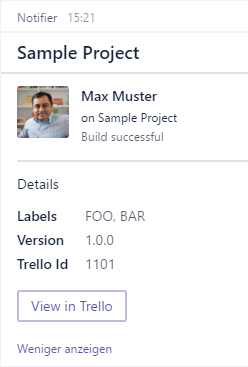Sending Notifications to a Microsoft Teams channel
In this article you will learn how to create a Office 365 webhook integration on a MS Teams channel and send a notification to it. This article assumes that you already have a Microsoft Teams team and channel setup.
Adding a Webhook Integration to a Channel
Follow the instructions for setting up a webhook connector to your channel. When finished, you should have a Webhook URL that looks like "https://outlook.office.com/webhook/some-random-text/IncomingWebhook/some/random/text".
Sending a Notification to the Webhook
1: 2: 3: 4: 5: 6: 7: 8: 9: 10: 11: 12: 13: 14: 15: 16: 17: 18: 19: 20: 21: 22: 23: 24: 25: 26: 27: 28: 29: 30: 31: 32: 33: 34: 35: 36: |
|
The result should look something like this:

For additional information on the parameters, check out the Office 356 Connectors API Reference
val webhookUrl : string
val imageUrl : (string -> string)
val sprintf : format:Printf.StringFormat<'T> -> 'T
val notification : p:'a -> 'a
val p : 'a
union case Option.Some: Value: 'T -> Option<'T>
namespace System
Multiple items
type Uri =
new : uriString:string -> Uri + 5 overloads
member AbsolutePath : string
member AbsoluteUri : string
member Authority : string
member DnsSafeHost : string
member Equals : comparand:obj -> bool
member Fragment : string
member GetComponents : components:UriComponents * format:UriFormat -> string
member GetHashCode : unit -> int
member GetLeftPart : part:UriPartial -> string
...
--------------------
System.Uri(uriString: string) : System.Uri
System.Uri(uriString: string, uriKind: System.UriKind) : System.Uri
System.Uri(baseUri: System.Uri, relativeUri: string) : System.Uri
System.Uri(baseUri: System.Uri, relativeUri: System.Uri) : System.Uri
type Uri =
new : uriString:string -> Uri + 5 overloads
member AbsolutePath : string
member AbsoluteUri : string
member Authority : string
member DnsSafeHost : string
member Equals : comparand:obj -> bool
member Fragment : string
member GetComponents : components:UriComponents * format:UriFormat -> string
member GetHashCode : unit -> int
member GetLeftPart : part:UriPartial -> string
...
--------------------
System.Uri(uriString: string) : System.Uri
System.Uri(uriString: string, uriKind: System.UriKind) : System.Uri
System.Uri(baseUri: System.Uri, relativeUri: string) : System.Uri
System.Uri(baseUri: System.Uri, relativeUri: System.Uri) : System.Uri
val ignore : value:'T -> unit